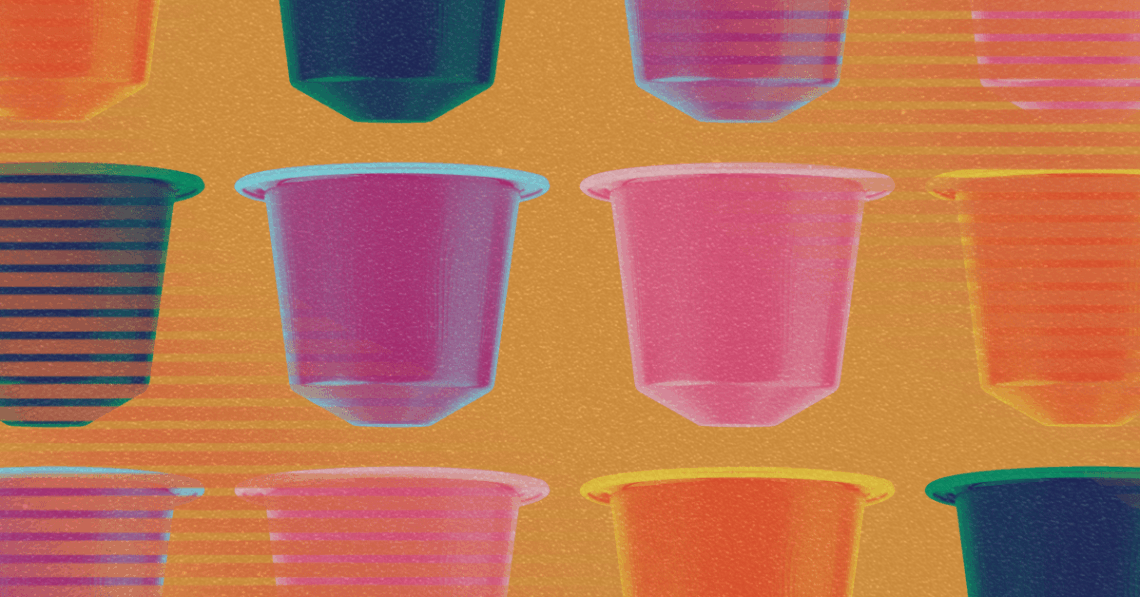Each morning, millions of Americans press a single button for a hot cup of coffee. As much as they enjoy the instant comfort, it may have hidden health costs.
Like many other kitchen products, the pods and cups used inside these coffee machines often contain plastic materials. Studies find these materials can shed microplastics, which are then released into the coffee—and emerging research suggests that long-term exposure to microplastics in general may compromise health. In 2024, researchers showed that patients with microplastics in their arteries had higher risk of heart attack, stroke, and early death.
“We already have evidence that many plastics and related microplastics contain hazardous chemicals that can cause harm,” says Justin Boucher, an environmental engineer and operations director of the Food Packaging Forum, a nonprofit that tracks research on how materials affect food.
Scientists are finding that coffee pods and cups may contribute to this problem.
Reason for concern
Many coffee pods and single-serve cups include plastics that break down as coffee is made. They can wind up in your drink, making for a cocktail of convenience, caffeine, and microscopic debris.
Microplastics are pieces of plastic smaller than five millimeters. They have become ubiquitous due to our heavy reliance on plastic and get into our bodies in several ways. One path is through plastic food packaging; their microplastics can migrate, along with plastic-related chemicals, into the food.
Because they’re so small, microplastics are absorbed and carried by the blood to vital organs. Lab studies of human cells and animals show they can cause inflammation, oxidative stress, and immune disturbances—issues that contribute to a variety of diseases.
What’s currently lacking is clear evidence that microplastics directly cause these illnesses, says Mohamed Abdallah, professor of environmental chemistry at the University of Birmingham in the U.K. “Our understanding of the toxicity of microplastics remains in its infancy,” Abdallah adds. But he thinks we know enough for people to be concerned.
Much like the inside of your body, it’s important to understand the inner workings of your single-cup coffee machine. It heats the water to about 190°F, just shy of boiling, and forces it through the pod under high pressure. As the brewed coffee is released from the pod, the heat and pressure cause the plastic to release chemicals and fragment into tiny pieces, which then slip quietly into the dark brown swirl.
Read More: What Happens to the Plastic in Dishwasher Pods?
This year, Abdallah published research on three different brands of coffee pods. When he inspected the coffee made from the pods, he found significant levels of microplastics. He confirmed the source of these microplastics by tracing them back to the same kind of plastic used to make each pod.
Christopher Helt, a toxicologist and director of the GreenScreen Certified® program, run by the nonprofit Clean Production Action, notes “there is clear opportunity for migration of chemical additives into the coffee.” But he also thinks contamination could be limited because the pods are exposed to high heat and pressure for a relatively short time—only a minute or so.
Abdallah says findings may diverge based on the particular methods chosen to measure microplastics and related chemicals. “Depending on what you look at, the numbers vary,” he explains. For instance, studies may use different mesh sizes to filter the microplastics, Abdallah says.
A 2020 paper by University of Connecticut researchers found that chemicals from plastic pods get into the coffee at low levels, but they didn’t look specifically at microplastics, as Abdallah did.
More research is needed. “Overall, highly reliable studies on the topic are lacking,” says Lisa Zimmermann, a biologist and science communication officer at the Food Packaging Forum. But she adds that materials in cups and pods are “highly complex with many different ingredients, which are needed to withstand high heat and pressure inside the machines.” With that kind of complexity, combined with the high heat and pressure, “you have many more chemicals that can migrate into the coffee,” Boucher says.
The U.S. Food and Drug Administration (FDA) has yet to establish relevant standards for assessing exposure to microplastics in food. “The federal government hasn’t done anything specifically related to microplastics,” says Tracey Woodruff, a health policy professor at the University of California, San Francisco, and former senior scientist in the U.S. government. The FDA didn’t respond to TIME’s request for comment.
A strong alternative
Given the research on potential hazards, Boucher and Zimmermann see value in taking a precautionary approach. One alternative, in particular, is safer and less expensive in the long run: pods and cups made of stainless steel.
Stainless steel is safer to heat than plastic. “The complex chemistry needed to retain plastic’s physical properties isn’t needed to protect stainless steel,” Boucher says. The steel pods cost more initially, but they can be washed and used repeatedly, as opposed to single-use plastic. Third-party companies design them to be compatible with popular machines like Keurig and Nespresso.
Some companies advertise pods and cups made with bioplastics that are at least partly plant-based—or intended to mimic plant-based versions—with potential health and environmental benefits. But the replacements are still made of complex materials that include additives like colorants; the chemicals can react in ways the companies may not intend or understand, Boucher says.
Read More: The Dirty Secret of Alternative Plastics
Biomaterials like corn starch—used in some alternative cups—have their advantages, but they could still be hazardous, Helt says. Some research suggests bioplastics are just as toxic as other plastics.
Meanwhile, Nespresso’s pods are mostly aluminum. However, a Nespresso representative confirmed by email that their capsules contain a small amount of non-aluminum materials, which may include plastic.
Keurig, which sells the popular coffee pods K-Cups, didn’t reply to TIME’s requests for comment. The Plastics Industry Association, a trade association, provided no comment.
Other sources of microplastics
Plastic pods and cups aren’t the only drivers of microplastics to your morning brew. “There are so many different pathways,” Abdallah says.
One is the machine itself, as its inner parts are typically plastic—both in single-cup brewers and drip coffee makers. In the same 2025 study, Abdallah found microplastics in coffee drinks that had originated from the machine, in addition to ones from the pods and cups. He analyzed a machine that was eight years old and newer machines about one year old. “The older machine released more microplastics than the two newer versions,” Abdallah says.
When considering your coffee maker’s age, think about a lawn chair made of PVC. “After it sits in your backyard in the sun for a few months or years, it can just start disintegrating,” Boucher says. High heat has a similar effect on your machine.
Read More: Scientists Are Finding Out Just How Toxic Your Stuff Is
Single-cup machines often have external water tanks made of plastic. “That can be a source of microplastics, too,” Abdallah says. The water itself may contain microplastics even before it goes through the machine. However, the coffee coming out the other end has almost two-thirds more of these contaminants, Abdallah found.
And then there’s milk, if you’re adding it. “Milk can travel through hundreds of feet of plastic tubing during its production phase,” Boucher says, potentially resulting in more microplastics.
Coffee may contain yet more microplastics if you drink it from disposable paper cups; some are lined with plastic. When possible, choose glass instead, Abdallah says. The Food Packaging Forum keeps a research database on plastics contaminating food, including paper cups.
These other sources of microplastics, associated with long-term use of coffee pods, may add up to increase health risks. Researchers think people can reduce risk by using stainless steel pods. Woodruff went a step further: she bought a stainless-steel machine.
Integrate these improvements gradually to limit your plastics-related stress. Woodruff looks back on her own efforts over time as a journey. “I didn’t switch out all of this stuff overnight,” she says. “People should just remember not to blame themselves—and broader change depends on government and industry action. Do what you can do.”
The post What Happens to the Plastic in Single-Serve Coffee Pods? appeared first on TIME.




